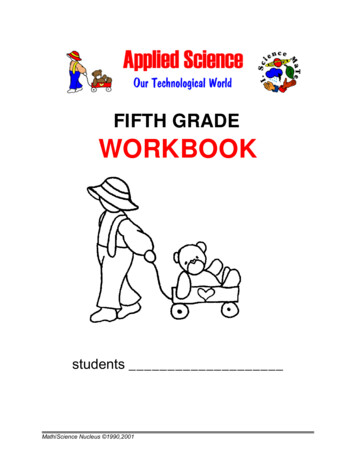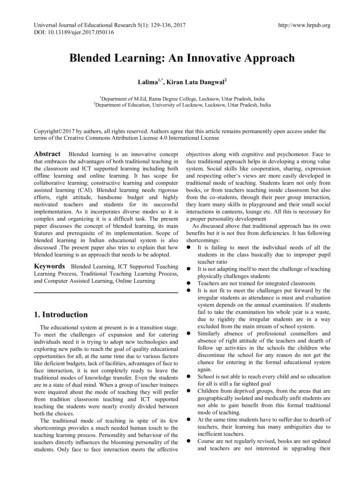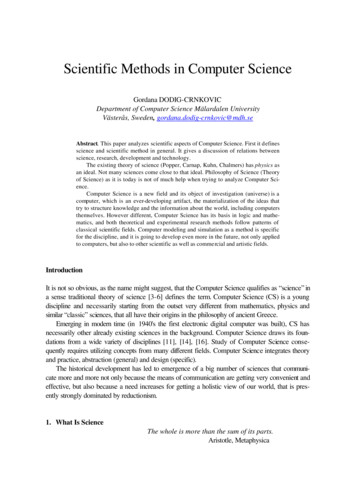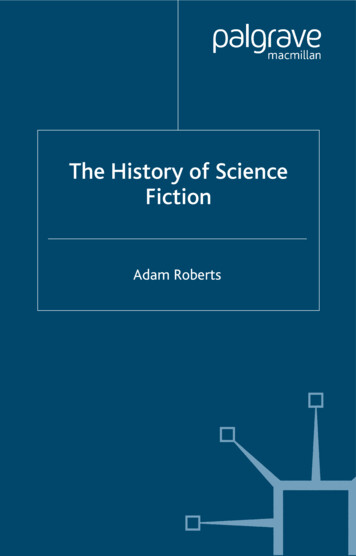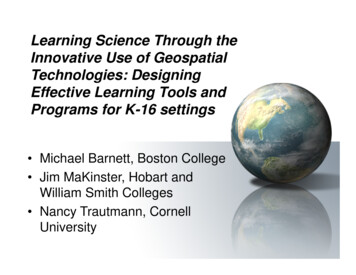
Transcription
Learning Science Through theInnovative Use of GeospatialTechnologies: DesigningEffective Learning Tools andPrograms for K-16 settings Michael Barnett, Boston College Jim MaKinster, Hobart andWilliam Smith Colleges Nancy Trautmann, CornellUniversity
Geospatial Technology Geographic InformationSystems Global PositioningSystems Virtual Globes– Google Earth– WorldWind– AcrGIS Explorer Web-based 2D and 3Dvisualizations
Why this session? “Learning to Think Spatially: GIS asa Support System in the K-12Curriculum” (National Research Council,2006)– Geographic information science has significantbut as yet unrealized potential in the K-12curriculum. In principle, GIS reflects many of theideals of exploration-driven, discovery-based,student-centered inquiry . Current GIS is toocumbersome and inaccessible for effectiveuse in K–12 education (p. 8).
Goals for the book This book will:– synthesize efforts to date thathave examined the learningoutcomes attributable to use ofgeospatial technology– develop a framework forthinking about teaching withgeospatial technology, and– explore various designprinciples within specificcontexts.
Goal for the Book/Session What are the issues facing educators usinggeospatial technology in terms of:– design?– development?– research? First book (Teacher PD) was organized by:– Research section– Design section Shift to themes
An Opportunity Document current efforts and projects– 21 chapter proposals received Explore the iterative design of projectsover time Forward a framework for thinking aboutdesign of geospatial learningenvironments Ask and explore a variety of specificquestions?– Role of geospatial technology inenvironmental education, geo edu., otherfields, etc
AudienceWho? Science education faculty, developers and researchersScience facultyGeography facultyMuseum or center staffAcademic researchersTeacher educatorsDoing what? Designing geospatial softwareConducting educational researchConducting science outreachDesigning learning environments for K-16 students
Book Structure Introduction– Role of Geospatial technologiesin support learning in thegeosciences– Role of geospatial technologiesin support of learning ingeography Themed based book todecided by the communities’feedback, insights, and ideas Closing chapter– Hopefully collaborative 21 proposals received
Title Word Splash
Contributing Authors Walt Allen – Foundation for Blood ResearchAlec M. Bodzin – Lehigh UniversitySarah Bednarz – Texas A&M UniversityBob Coulter – Litzsinger Road Ecology CenterJacqueline Ebenezer, Wayne State UniversityDaniel Edelson – National GeographicJanice Gobert – Worcester Polytechnic InstituteRita Hagevik – University of Tennessee at KnoxvilleBob Kolvoord – James Madison UniversityFred Martin – University Massachusetts LowellJames Matthews – University of WisconsinCatherine Stylinski – University of Maryland Center for EnvironmentalScienceKenneth Yanow – Southwestern CollegeDaniel Zalles – SRI
Important Dates: Tentative December 1, 2009: Chapter Proposal SubmissionDeadline March 15, 2010: Notification of Acceptance– Still working on structure of the book and acceptingproposals!! May 1, 2010: Full Chapter Submission June 15, 2010: Chapter Review Returned September 1, 2010: Revised Chapter SubmissionDeadline January 1, 2011: Book Draft Submitted to Springer To Be Determined: Final Revisions Based on FeedbackFrom Springer
Questions?Michael BarnettBoston Collegebarnetge@bc.eduJames G. MaKinsterHobart and William Smith Collegesmakinster@hws.eduNancy M. TrautmannCornell Lab of Ornithologynmt2@cornell.edu
Ideas to answer What are the outstanding issues in terms ofgeospatial technologies in K-12 education? Others (yours) projects for inclusion in the book? Other general chapters?
Learning to Think Spatially: GIS as a Support System in the K-12 Curriculum ” (National Research Council, 2006) – Geographic information science . has significant but as yet unrealized potential. in th





